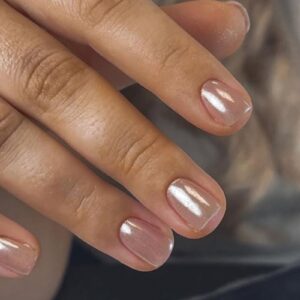
Nail ridges: an expert shares causes & how to treat
By Guest Writer | 20 November 2024 | Expert Advice, Feature

Scratch Stars Natural Nail Specialist of the Year 2019 & CND™ education ambassador, Helen Burton-Ward, explores ridges on natural nails…

There are many types of nail ridges, which can occur naturally or be inflicted by mechanical or environmental factors. Understanding how to correctly manage and treat them will help to maintain the health of the nail plate and prevent any conditions worsening unnecessarily.
Rings of fire
Rings of fire will appear as red rings on the nail plate near to the proximal nail fold. They are usually accompanied by a dip or ridge and are caused by the improper use of a manual file or E-file. It is imperative that non-living tissue is removed safely and correctly, E-files don’t come into contact with the nail plate and manual files are not used aggressively (240-grit should only be used on the natural nail!)
Caution should be taken when applying coatings to damaged nails. An already compromised nail will not hold product well. Keep nails presenting rings of fire short, as they will be thin, and a thorough aftercare plan involving cuticle oil is important.
Habit tic
Habit tic presents as a series of horizontal ridges across the nail plate: often on the thumb. This is a result of continuous (habitual) picking of the proximal nail fold. While damaging, this will normally correct itself – but do not attempt to buff the ridges out, as this will only thin the nail. Product can be safely applied to nails with habit tic, and in fact, using a product to smooth out ridges may prevent or discourage further picking.

Age-related ridges
Age-related ridges
These ridges occur longitudinally down the nail plate and usually affect only a few nails; usually the same nail on each hand will be impacted, such as both thumbs or both ring fingers. Age-related ridges cannot be corrected and may worsen with time. Again, do not attempt to buff these ridges out. Instead, use a product designed to camouflage ridges, such as CND™ RidgeFX.
If the ridges are deep, it may make nails prone to splitting at the free edge. In this circumstance, an enhancement coating may better support nails, but a thorough consultation will identify if this is the case.
Beau’s lines
Beau’s lines appear as horizontal ridges and will normally affect all 10 nails. These occur due to the body’s response to ill health or a dip in the immune system, whereby the matrix slows in its production, which results in a visible ridge.
The condition will usually grow out as the person recovers. Do not attempt to buff the ridge out, as this will further thin the nail plate. In some instances, you may be able to apply a nail coating, however a thorough consultation is required beforehand to assess any potential health conditions that may be contraindications.
Follow Helen on Instagram and Facebook.
Originally published in 2020.

Read the latest issue









